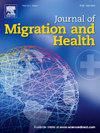Delivering obstetric care to maritime migrants: The Lampedusa protocol
IF 2.9
Q1 PUBLIC, ENVIRONMENTAL & OCCUPATIONAL HEALTH
引用次数: 0
Abstract
Background
While Lampedusa Island has long represented the “Doorway to Europe,” migration is considered an emergent phenomenon rather than a constant occurrence. Vulnerable populations – particularly pregnant women – arriving there require both routine and urgent medical services. We describe a novel approach to triaging pregnant migrant women, observed clinical presentations, and the effects on healthcare resource utilization.
Methods
The Lampedusa Protocol was implemented in March 2023 by the Agenzia Sanitaria Provinciale (ASP) of Palermo and the Italian National Institute for Health, Migration and Poverty (INMP). Clinical and demographic data from 28 March 2023 to 31 May 2024 were collected and analyzed by cross-referencing the clinical databases of the policlinic of Lampedusa and the Italian Red Cross, the managing entity of the migrant hotspot. Resource utilization data were collected from the helicopter transfer data recorded by the emergency medical service for the island. Associations between patient characteristics and need for helicopter evacuation were assessed using multivariable logistic regression.
Findings
A total of 571 pregnant patients were assessed and treated between 3/28/2023-5/31/2024. Patients represented 23 nationalities, average age was 26 years (SD=6.6 years), and average ultrasound-estimated gestational age was 25.2 weeks (SD=9.6 weeks). The most common causes for needing helicopter transfer were late gestational age or concern for, or symptoms of, labor. Compared to the pre-implementation period, the proportion of patients requiring any flight decreased by 23% (24.5% to 18.9%, p= 0.027) and the proportion requiring dedicated urgent flights decreased by 52% (8.3% to 4.0%, p= 0.003) in the post-implementation period. No association was found between Multidimensional Global Poverty Index of origin country and requiring helicopter evacuation. Women with known nationality had reduced odds (OR = 0.49, 95% CI = 0.27-0.90, p = 0.02) of requiring urgent helicopter evacuation.
Interpretation
We demonstrate improved resource utilization with protocolized care pathways for maritime migrants in European borderlands.
Funding
Dr. Alexandra Sansosti, MD was funded in part by a research grant from the US-Italy Fulbright Commission for this project.
向海上移民提供产科护理:兰佩杜萨议定书
虽然兰佩杜萨岛长期以来一直代表着“通往欧洲的门户”,但移民被认为是一种新兴现象,而不是经常发生的现象。到达那里的弱势群体,特别是孕妇,需要常规和紧急医疗服务。我们描述了一种新的方法来鉴别怀孕的移民妇女,观察到的临床表现,以及对医疗资源利用的影响。方法《兰佩杜萨议定书》由巴勒莫省卫生机构(ASP)和意大利国家卫生、移民和贫困研究所(INMP)于2023年3月实施。收集了2023年3月28日至2024年5月31日的临床和人口统计数据,并通过交叉参考兰佩杜萨岛诊所和意大利红十字会(移民热点管理实体)的临床数据库进行了分析。资源利用数据是从岛上紧急医疗服务记录的直升机转移数据中收集的。使用多变量logistic回归评估患者特征与直升机疏散需求之间的关系。在2023年3月28日至2024年5月31日期间,共对571例孕妇进行了评估和治疗。患者来自23个国家,平均年龄26岁(SD=6.6岁),超声估计平均胎龄25.2周(SD=9.6周)。需要直升机转运的最常见原因是妊娠晚期或担心分娩或分娩症状。与实施前相比,需要任意航班的患者比例下降了23% (24.5% ~ 18.9%,p= 0.027),实施后需要专门紧急航班的患者比例下降了52% (8.3% ~ 4.0%,p= 0.003)。原籍国多维全球贫困指数与需要直升机疏散之间没有关联。国籍已知的女性需要紧急直升机疏散的几率降低(OR = 0.49, 95% CI = 0.27-0.90, p = 0.02)。我们展示了通过对欧洲边境海上移民的协议化护理途径改善了资源利用。Alexandra Sansosti医学博士是由美国-意大利富布赖特委员会为该项目提供的部分研究资助。
本文章由计算机程序翻译,如有差异,请以英文原文为准。
求助全文
约1分钟内获得全文
求助全文
来源期刊

Journal of Migration and Health
Social Sciences-Sociology and Political Science
CiteScore
5.70
自引率
8.70%
发文量
65
审稿时长
153 days
 求助内容:
求助内容: 应助结果提醒方式:
应助结果提醒方式:


